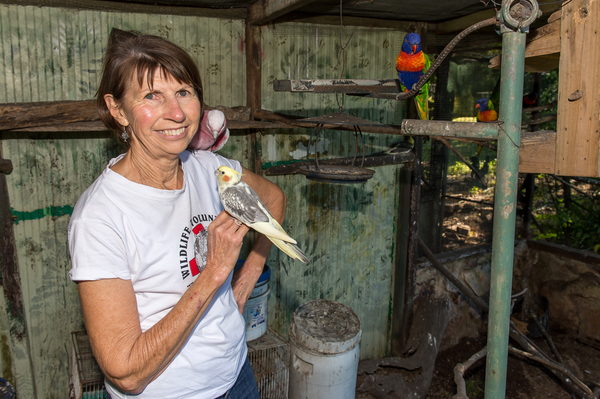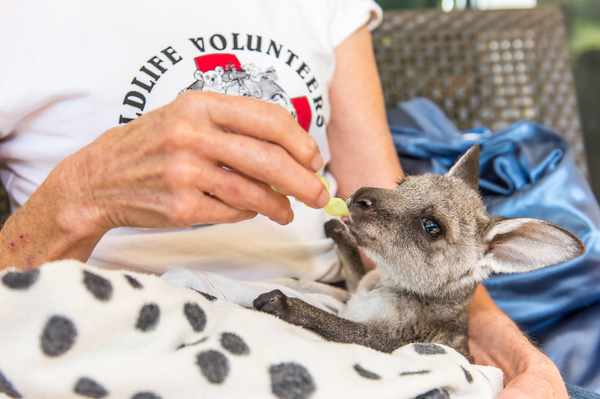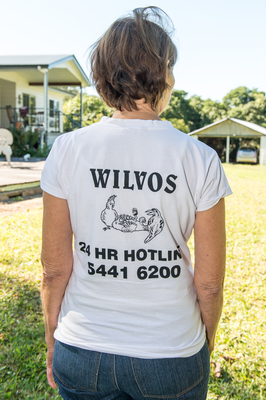By Margaret Maccoll
About 90 per cent of Wilvos’ injured wildlife arrives due to the behaviour of people – whether it’s as a result of a car strike, dog or cat attack, barbed wire or a bird flying into a window.
Monday 5 June was World Environment Day and to mark the occasion, Noosa Today spoke to one of the Sunshine Coast’s foremost wildlife rescuers.
As a girl in primary school Sylvia Whiting wanted to be a vet. Now, after caring for wildlife for 30 years, vets often take the advice of the Wilvos president.
The Wildlife Volunteers Association, or Wilvos as it was dubbed was set up 30 years ago by the then Department of National Parks and Wildlife, initially to operate a helpline for people who found sick and injured wildlife after hours.
About 30 people joined up to answer phone inquiries and they were given a book with information on caring for the animals. A few years later the department became too busy to answer the daytime inquiries and it was handed to Wilvos 24 hours a day.
Sylvia said it was a tough road for the volunteers for a long time, with little equipment or money.
But when she was awarded a Pride of Australia Medal followed in 2011 by an Order of Australia Medal for her dedication to conservation “it was good for Wilvos”.
A “substantial donation” given by an anonymous donor, some grants and government funding have enabled them to provide training and equipment, such as nest boxes, to members and education in schools.
The organisation is now run by an elected committee with Sylvia as its president and has about 300 members including about 130 carers.
Based in the Sunshine Coast, it covers an area of about 6000 square kilometres from Gympie in the north to the northern Brisbane suburbs and west to Imbil and Kilcoy. In any year the hotline which is manned by volunteers on a roster system can receive 10,000 calls.
“Not every call is for animal services, some just want to know information,” Sylvia said.
“It costs about $25,000 a year to run,” she said and a portion of that money is used to bring in animal experts who deliver workshops to members.
Sylvia, who takes in about 400 animals a year, has her daily life dictated by the feeding times of her wards.
“At the moment I have six macropods. They have four-hourly feeds throughout the night. There are possums on formula feeds and birds are short-term, they come and go,” she said.
Wilvos acts as an indicator of the broader wildlife population and over the years they have witnessed development expand while wildlife and natural habitat decline.
Birds such as the scaly-breasted lorikeets are rarely seen now where once they flew in flocks as large as the more common lorikeet and the phascogale, a carnivorous possum, quolls and gliders are no longer commonly seen. Sylvia said people sometimes phoned very excited to have found a bilby, but they always turned out to be bandicoots.
She says she’s always amused at the denial of pet owners who ring when their dog or cat has brought in a bird.
“About three months ago a woman rang to saw her cat had brought in a rosella,” she said. ‘She didn’t hurt it’ the woman said of her cat. “When I got there the thing was plucked, it just had a bit of fluff on it,” Sylvia said.
Sylvia says when people assume their pet has done no damage to a bird and put in back in the bush, that bird will die.
“Just the saliva from a cat is enough to kill them. It is full of bacteria and when they clean themselves they ingest it. We always wash them and give them antibiotics. Dogs shake them and that causes internal damage. Sometimes they’re very traumatised.
“We make them warm and give them pain relief. Everything feels pain. And we give them a go.”
The organisation runs regular induction sessions to enlist the help of more volunteers.
Sylvia said on average about two people continued to work with them.
“It doesn’t always fit in with people’s lifestyle. Some change their minds, some say it’s too hard. Then there are some people you can really rely on. We do appreciate all the help we get.”
Sylvia said rescuing animals had put her and husband, Bob, in some tricky situations.
Once she had a call about an injured kangaroo. When they arrived they found a mob of kangaroos with a very protective male. A female that had been hit by a car had made it to a paddock close to the road and had died, but its joey was injured and needed help.
“The male was grabbing her to get her up,” she said.
“It’s surprising how protective they are and how hard they work to get their mate up.
“We drove the car out there between mum and dad. I jumped out and grabbed the joey. The little thing had a badly fractured leg. I said quickly get in the car. Here comes the male. He was roaring at us. He would have had us.”
Sylvia said the protective nature of wildlife regularly caused their demise, particularly when birds hit by cars were left on the road.
“If a bird’s dead on the road its mate will keep swooping at it to try and get it off,” she said. “They often get squished as well. It’s really sad. These things have feelings.”
Despite her thousands of wards over many years there are two breeds that stand out – the greater glider and phascogale.
She was delighted when a baby phascogale came into her care.
“A Yandina vet had this tiny creature. She called me and said would you like to give it a go.
“I said could you give it some fluids. It survived. It was so cute. As it got bigger it was so fast. I had to catch moths to feed it. It would zap around the cage to catch them.”
The greater glider still eludes her.
For more information on Wilvos visit www.wilvos.org.au The emergency hotline is 5441 6200.









